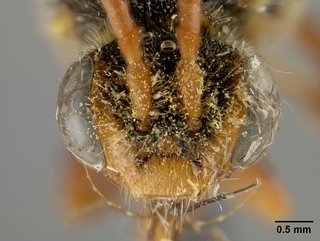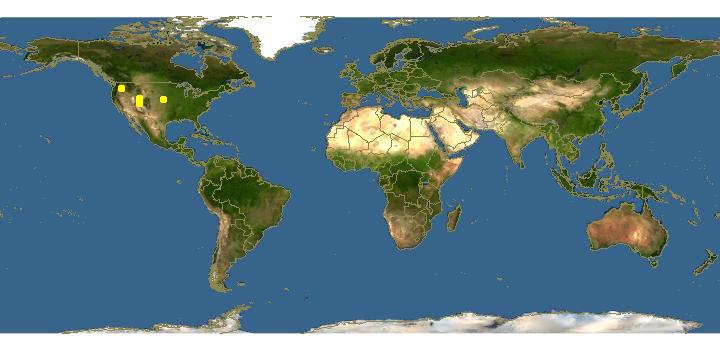
Smithsonian Institution, Entomology Department · -9
Nomada civilis spokanensis, female, face |

Click on map for details about points.
|
|
Overview |
Reprinted from: Cresson, E.T., 1878. Descriptions of new North American Hymenoptera in the collection of the American Entomological Society. Trans. Am. Entomol. Soc.7:78.
Black, opaque; head and thorax densely and
confidently punctured and thickly clothed with short pale pubescence; sides
of face extending narrowly up on anterior orbits, clypeus, sometimes % spot
above, labrum. mandibles except tips, posterior orbits, scope beneath, line or
two spots on collar, sometimes wanting, tubercles, irregular mark beneath,
occasionally a small spot on eaeh side of metathorax, and the tegula yellow ;
scape robust, fiagellum ferruginous with a black line above, second joint a
little shorter than third: scutellum uot at all prominent; wings faintly dusky
at tips; legs yellow, coxa at b.ise, all the femora behind more or less, and a
spot on all the tibia bebiud, black; tarai more or less ferruginous; abdomen
shining, yellow, basal half of first segment and narrow basal margin of re
maining segments black, apical margin of segments 1?4 narrowly fuscous,
anterior margin of yellow band on first segment sinuate; venter yellow, some
times banded with black. Length .3??.45 inch.
Hab.?Colorado, (Hidings, Morrison). Nine specimens. This is
closely allied to the o of tute?la St. Farg.
|
|
|
Identification |
Extracted from New American Bees - VIII by Cockerell (1909).
Cresson described this from nine males collected in Colorado.
It is very variable, both in size and markings. At Troublesome,
Colorado, alt. 7345 ft., June 9th, 1908, l\fr. S. A. Rohwer took
both sexes. The female runs in my table of Rocky :Mountain
Nomada (Bull. 94, Colo. Expel'. Sta.) to N. agynia, male, but is
quite distinct from that species. As is usual in the group to
which the species belongs, the female N. civilis is very unlike
the mala, agreeing, however, in the very broad face, with the
orbits diverging above. The following characters of the female
are distinctive :-
Lower part of face, including labrum and supraclypeal mark,
lemon-yellow; orbital margins above middle of face broadly ferruginous,
this continuing over to the cheek, on the lower half or more
of which it gives way to yellow; scape ordinary, yellow in front,
antennm otherwise wholly ferruginous, without black or dusky;
mesothorax rough, black, with a little red at extreme sides; tegulm
light ferruginous, with a yellow spot in front; tubercles and upper
margin of prothorax yellow; pleura ferruginous, with a suffused
yellow patch; scutellum and postscutellum yellow, with reddish
hair; metathorax black, with a pair of large round light red spots,
varying to slightly yellowish in the middle; legs clear ferruginous
red, the apices of the femora and anterior and middle tibim conspicuously
marked with yellow; abdomen bright lemon-yellow, with
clear ferruginous bands above and below; on the first segment the
yellow is reduced to a mark (one-third of a band) on each side, and
there is a black subbasal median spot; on the second segment the
yellow is much narrowed in the middle.
Extracted from Western Bees obtained by the American Museum Expeditions by Cockerell (1921).
IDAHO: 1 :Montpelier, about 6100 ft. alt., near town, July 6, 1920.
There are two large yellow spots on scutellum, but in some examples
of N. civilis (for example, from Florissant, Colorado) these are absent.
|
|
|
Names | |
|
|
| Supported by | |
Updated: 2024-04-29 08:28:02 gmt
|